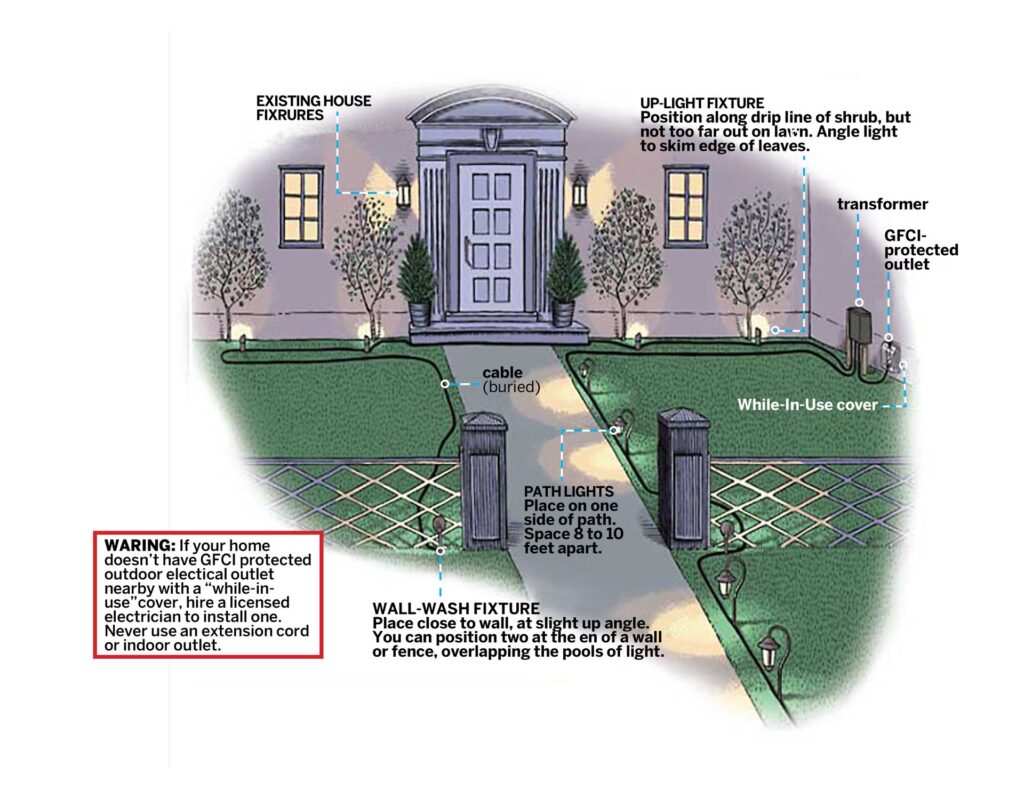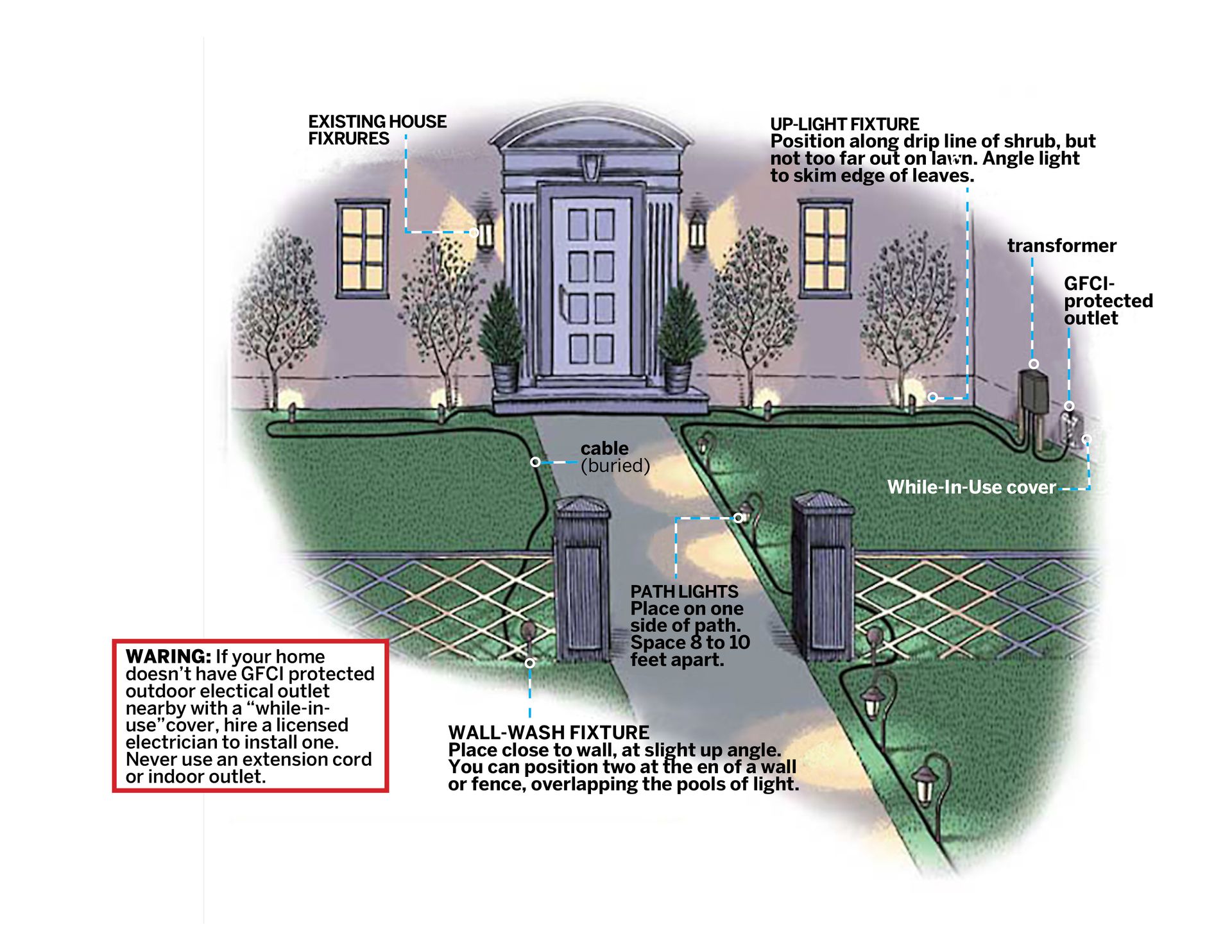
Illuminating Your Outdoors: Where to Place Landscape Lighting for Maximum Impact
Landscape lighting is more than just adding a few lights to your yard; it’s about creating an ambiance, enhancing safety, and highlighting the best features of your property. Knowing where to place landscape lighting is crucial for achieving the desired effect. Poorly placed lights can be ineffective, create unwanted glare, or even detract from your home’s beauty. This comprehensive guide will walk you through the essential considerations for optimal landscape lighting placement, ensuring your outdoor spaces are both beautiful and functional.
Understanding the Goals of Landscape Lighting
Before diving into specific placements, it’s important to define your goals. What do you want to achieve with your landscape lighting? Common objectives include:
- Security: Deterring intruders and improving visibility around walkways and entrances.
- Safety: Illuminating pathways, steps, and uneven surfaces to prevent accidents.
- Aesthetics: Highlighting architectural features, plants, and water features.
- Ambiance: Creating a welcoming and relaxing outdoor atmosphere for entertaining or personal enjoyment.
Once you’ve identified your goals, you can start planning your landscape lighting design and determining the best locations for your fixtures.
Key Areas to Illuminate
Here’s a breakdown of key areas around your property and how to effectively light them:
Pathways and Walkways
Safety is paramount when lighting pathways. Consider using path lights spaced evenly along the walkway to provide consistent illumination. Avoid placing lights too far apart, as this can create dark spots. Downlighting, where lights are mounted higher up and directed downwards, can also be effective for illuminating pathways without creating glare. Remember, the goal is to provide enough light to see clearly without being overly bright. This consideration is key when deciding where to place landscape lighting.
Driveways
Driveways require strong, reliable lighting for both safety and security. Post lights or bollard lights placed along the driveway edges can clearly define the driving area. Consider using motion-sensor lights near the entrance to alert you to approaching vehicles or pedestrians. Avoid aiming lights directly at oncoming traffic to prevent blinding drivers. Strategic landscape lighting here can significantly enhance security.
Entrances and Porches
The entrance to your home is a focal point and should be well-lit. Porch lights or sconces flanking the front door create a welcoming atmosphere. Consider adding uplighting to highlight architectural details such as columns or gables. Use warm-toned lighting to create a cozy and inviting feel. Careful planning of where to place landscape lighting around entrances is crucial for curb appeal.
Gardens and Planting Beds
Landscape lighting can dramatically enhance the beauty of your garden at night. Uplighting trees and shrubs creates a dramatic effect, while downlighting can cast soft shadows and highlight textures. Consider using spotlights to showcase individual plants or sculptures. Avoid over-lighting your garden, as this can wash out the colors and details. Experiment with different lighting techniques to find the perfect balance. Knowing where to place landscape lighting in your garden can transform its nighttime appearance. [See also: Garden Lighting Ideas for Small Spaces]
Water Features
Water features, such as fountains, ponds, and waterfalls, can be stunningly illuminated with underwater lights. These lights create a magical effect, highlighting the movement and texture of the water. Be sure to use submersible lights specifically designed for underwater use. Consider using colored lights to add a touch of drama. The placement of these lights is critical to avoid glare and maximize the visual impact. Think carefully about where to place landscape lighting around water features.
Patios and Decks
Patios and decks are outdoor living spaces that should be well-lit for entertaining and relaxation. String lights or bistro lights create a festive atmosphere, while recessed lighting provides subtle, ambient illumination. Consider adding task lighting to areas where you’ll be grilling or preparing food. Use dimmers to adjust the lighting levels to suit different occasions. The right landscape lighting can make your patio or deck a more inviting and usable space. [See also: Deck Lighting Installation Guide]
Architectural Features
Highlighting the architectural features of your home with landscape lighting can dramatically enhance its curb appeal. Uplighting columns, gables, and other architectural details creates a dramatic effect. Consider using spotlights to showcase interesting textures or materials. Avoid over-lighting your home, as this can make it look artificial. Subtlety is key when highlighting architectural features. Choosing where to place landscape lighting for architectural accents requires careful consideration of angles and intensity.
Types of Landscape Lighting Fixtures
Choosing the right fixtures is just as important as choosing the right locations. Here’s a brief overview of common landscape lighting fixture types:
- Path Lights: Low-level lights designed to illuminate pathways and walkways.
- Spotlights: Focused beams of light used to highlight specific objects or areas.
- Floodlights: Wide beams of light used to illuminate larger areas.
- Uplights: Lights that shine upwards, typically used to illuminate trees or architectural features.
- Downlights: Lights that shine downwards, often used for pathways or patios.
- String Lights: Decorative lights that add a festive touch.
- Bollard Lights: Short, sturdy lights often used along driveways or walkways.
Planning Your Landscape Lighting Design
Before you start installing lights, it’s essential to create a plan. Here are some tips for planning your landscape lighting design:
- Start with a sketch: Draw a rough sketch of your property and mark the areas you want to illuminate.
- Consider the viewing angles: Think about how your landscape lighting will look from different vantage points, both inside and outside your home.
- Experiment with different lighting techniques: Try out different types of fixtures and lighting techniques to see what works best for your property.
- Use a dimmer: Install dimmers to control the brightness of your lights and create different moods.
- Consider energy efficiency: Choose LED lights to save energy and reduce your electricity bill.
- Think about maintenance: Choose durable fixtures that are easy to maintain.
DIY vs. Professional Installation
Installing landscape lighting can be a DIY project, but it’s important to consider your skills and experience. If you’re comfortable working with electricity and have some basic wiring knowledge, you may be able to install the lights yourself. However, if you’re not confident in your abilities, it’s best to hire a professional. A professional installer can ensure that your lights are installed safely and correctly, and they can also help you design a landscape lighting plan that meets your specific needs.
Common Mistakes to Avoid
Here are some common mistakes to avoid when planning your landscape lighting:
- Over-lighting: Using too many lights or lights that are too bright can create glare and wash out the colors of your landscape.
- Poor placement: Placing lights in the wrong locations can be ineffective or even detract from your home’s beauty.
- Using the wrong fixtures: Choosing fixtures that are not appropriate for the intended purpose can result in poor lighting.
- Ignoring safety: Failing to follow safety precautions when working with electricity can be dangerous.
- Not considering maintenance: Choosing fixtures that are difficult to maintain can lead to problems down the road.
Maintenance Tips
To keep your landscape lighting looking its best, it’s important to perform regular maintenance. Here are some tips:
- Clean the lenses regularly: Use a soft cloth to clean the lenses of your lights to remove dirt and debris.
- Replace burned-out bulbs promptly: Replace burned-out bulbs as soon as possible to maintain consistent illumination.
- Trim vegetation: Trim any vegetation that is blocking the light from your fixtures.
- Check for damage: Inspect your fixtures regularly for damage and repair any problems promptly.
Conclusion
Knowing where to place landscape lighting is a critical aspect of creating a beautiful, safe, and functional outdoor space. By carefully considering your goals, the key areas to illuminate, and the types of fixtures available, you can design a landscape lighting plan that enhances your property’s curb appeal and provides years of enjoyment. Remember to prioritize safety, energy efficiency, and maintenance when making your lighting choices. With thoughtful planning and execution, your landscape lighting can transform your outdoor spaces into inviting and enchanting environments.

